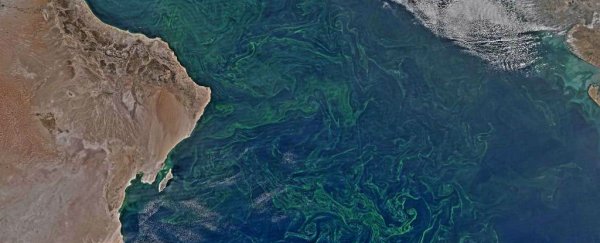An algae bloom the size of Mexico has appeared in the Arabian Sea, thanks to a growing 'dead zone' in the Gulf of Oman.
It's not the first time the build-up of green slime has appeared during the winter months, but the bloom now stretches all the way from the shores of Oman on the west, to India and Pakistan on the east, turning the waves "almost guacamole-like", according to a NASA biologist. And it's not a good sign for the local ecosystem.
While these algae blooms might look pretty from space or at night - they're the same 'sea sparkles' that are responsible for bioluminescence - up close, they can have serious consequences.
 Norman Kuring/NASA
Norman Kuring/NASA
Not only do they smell and look terrible, putting tourists off visiting local beaches, but these blooms can trigger the release of ammonia that poisons nearby marine life.
This Mexico-sized bloom is now forming twice a year in the Arabian Sea, and NASA satellite images show that it's growing.
So what's going on here?
The algae bloom is caused by Noctiluca scintillans - often called sea sparkles - which are microscopic dinoflagellates. These dinoflagellates are strange, tiny creatures that feed on plankton and suck up energy from the Sun via microscopic algae living within their cells.
In a typical marine ecosystem, they make up just a small part of the food chain. But when there's a build-up of plankton, they can form massive blooms that begins to dominate the local area. And that's not great for the environment.
"When the [sea sparkles'] cell breaks down, ammonia is released, and the massive bloom could become a deadly cloud," author and biologist Lisa Gershwin told Business Insider back in 2015, when a similar bloom occurred off the coast of Tasmania in Australia.
"It can change the flavour of the water and it's noxious to fish … As creatures go, it's more of the unwanted kind. In extreme cases it can cause fish kills; it does it all over the world," she added.
That's a massive threat for local industry, seeing as fishing sustains around 120 million people living on the edge of the Arabian Sea.
But what's really concerning is the fact that these dinoflagellate blooms weren't regularly seen until the past decade or so, and now are becoming increasingly common around the planet - particularly in the Arabian Sea.
 Norman Kuring/NASA and USGS
Norman Kuring/NASA and USGS
"It's unusual for Noctiluca to bloom in the open sea and return year after year," said Andrew Juhl, a microbiologist from Columbia University's Lamont-Doherty back in 2014.
"All of these observations suggest that something dramatic has changed in the Arabian Sea."
A separate team from Columbia University showed in a 2014 Nature Communications paper that the dinoflagellates have become more common in the region due to something called hypoxia, or lack of oxygen.
After monitoring the growth of the algae blooms for three years between 2009 and 2012, they found a dead zone the size of Texas had formed in the northern Arabian sea - which is a region where pollutants from human activity has depleted oxygen levels.
It's not entirely clear what's caused this patch of oxygen-starved sea, but the researchers hypothesise that it has something to do with rapid growth in the region over the past 30 years, and increased sewage run-off, which leads to a build of chemicals such as nitrogen and phosphorous.
Those conditions are toxic for a lot of marine life, but they're ideal for the plankton that N. scintillans feeds on.
Until recently, organisms called diatoms supported the Arabian Sea food chain. But in the early 2000s, vast blooms of N. scintillans began to build up, and there was a sharp drop in the number of diatoms in the region.
"Within a decade, Noctiluca had virtually replaced diatoms at the base of the food chain, marking the start of a colossal ecosystem shift," a Columbia University press release explains.
This isn't just changing things at the bottom of the food chain, but also further up - the crustacean grazers that usually feed on diatoms can't eat the sea sparkles.
There are concerns that the algae blooms could spawn an alternate food chain altogether, with more jellyfish and sea turtles, and less predatory fish.
The Arabian Sea isn't the only place suffering, though - as climate change increases ocean temperature around the planet, not only are algae blooms becoming more common, but so are these dead zones.
Warming ocean temperatures world-wide dredge up more nutrients from the ocean floor, which exacerbates the problem.
A 2008 study in Science found that, globally, dead zones have doubled in size each decade and now cover more than 153,000 square km (95,000 square miles) of the planet's oceans.
So we can get used to seeing more of these algae blooms in our oceans in future. But let's just hope researchers find a way to manage the problem before all our oceans are suffocated.
